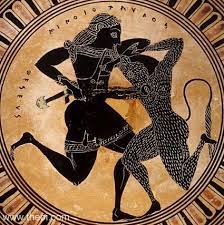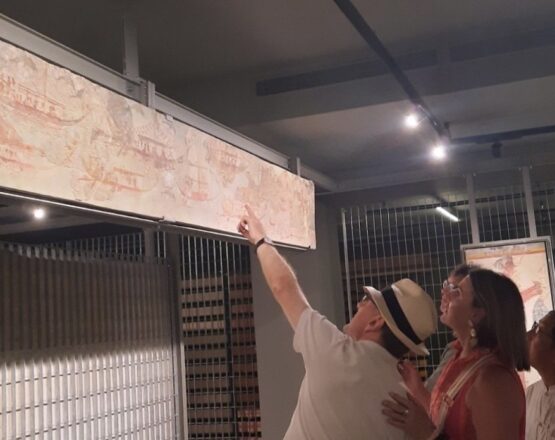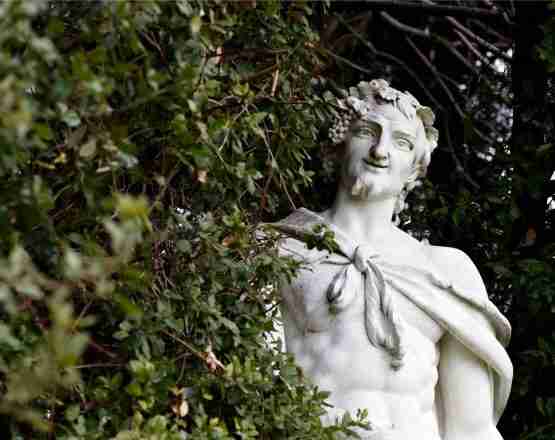The Minotaur’s Genealogy

The Minotaur’s form, possibly derived from Near Eastern iconography, was explained in Greek myth through the story of his birth. Minos wished to reign over Crete, but his rule was opposed by his brothers.
He claimed that he received rule over Crete from the gods, and as proof he said that whatever he prayed for would be accomplished.
So Poseidon send the most beautiful bull as evidence of his divine favour which Minos promised to sacrifice if the god granted his wish. When Poseidon sent the bull, Minos sacrificed another instead, keeping the bull from the sea for himself. In retribution, Poseidon inspired Pasiphae, Minos’ wife, to fall in love with the bull. With the help of a contraption made by Daedalos the inventor, Pasiphae mated with the bull and the Minotaur was born of their union. This story accounts for the Minotaur’s half human, half bull nature.
Although the Minotaur’s immediate birth story justifies his half-bovine nature, a much deeper understanding of his characterization can be gained from an analysis of his broader ancestry. The Minotaur was the child of sexual misconduct between Pasiphae and the bull, but in as much as Pasiphae’s attraction to the bull was the result of Minos’ impious act, the Minotaur may also be understood as the offspring of Minos. Therefore, a discussion of both Minos and Pasiphae’s ancestry is warranted.
In the earliest inscriptions found on pottery, the Minotaur is referred to only as the “bull of Minos.” Only after 400 BC is his name contracted from “minoio tauros” to “minotauros”.
This important etymological evidence demonstrates that the connection between Minos and the Minotaur was integral to the Minotaur’s original characterization.
It is not uncommon for a single mythological figure to have multiple fathers, such as Theseus who is son of both Poseidon and of Aegeus.
Minos also acts as the Minotaur’s caregiver and father when he imprisons the Minotaur in the labyrinth and feeds him the youths !
Through Minos, the Minotaur is connected with a constellation of myths that explore the geography and peoples of the Mediterranean.
His family history also demonstrates a repeated hieros gamos sacred marriage between god and cow or goddess and bull.
From this perspective, the Minotaur may be viewed as a perversion of the hieros gamos tradition, a tradition which has roots in the Near East.
Minos’ genealogy goes back to Io, daughter of Inachus.
It may be significant that Inachus is usually characterized as a river-god; Greek river-gods tend to metamorphosize into bovine forms (for example, Acheloos in combat with Herakles). One version of Io’s story is recounted in Prometheus Bound Io rebuffed Zeus’ advances, and was plagued by recurring nightmares. When she told her father, Inachus went to Delphi to inquire what they should do. Pythia instructed him to throw Io out “to roam at large the remotest confines of the earth” and that, if he did not, Zeus would destroy his whole race with a thunderbolt
In obedience with the oracle, Inachus threw Io out of Argos.
Io then changed into the form of a cow, growing horns, and was repeatedly stung by a gadfly that kept her moving around the Mediterranean
The gadfly was presumably sent by Hera, jealous of Zeus’ affection for Io.
Herodotos noticed the similarity between Io and the Egyptian goddess Isis. He writes that “the images of Isis are in woman’s form, horned like a cow, exactly as the Greeks picture Io, and cows are held by far the most sacred of all beasts of the herd by all Egyptians alike”
Io’s name is interpreted by some modern scholars as a Greek rendering of the Egyptian word for moon, “iooh”
The Egyptian Isis was represented as a cow or a woman with horns and a disk above her head, with either lunar or solar connections.
Io might also be seen as celestial bodies; Io’s wanderings with the movement of the moon through the sky.
The story of Io also has a close Near Eastern antecedent in the Neo-Assyrian birth incantation about the goddess Geme-Sin.
Here, the story is of a union between a divine bull and cow and it is one that gives good luck to the woman in birth
Thus, the figure of Io may be connected to Near Eastern figures in iconography, etymology, and literature.
The many places that Io visited during her wanderings are recounted in the Prometheus Bound at length
Her journey ends in Egypt, where “Zeus’ touch” brings her back to her senses and she begets Epaphos. Epaphos is often conceptualized as a black bull, which Herodotos equates with the Egyptian god Apis Epaphos, in union with Memphis (the female eponym of Egypt) gave birth to Libya. When Poseidon ravished Libya, she gave birth to Belus and Agenor. According to Apollodorus, Belus ruled in Egypt while Agenor ruled in Phoenicia
The story of Io thus posits a connection between Argos, Egypt, and Phoenicia through mythical genealogy.
Io’s bovine journey is repeated in the story of Europa Agenor, ruler of Phoenicia and descendant of Io, married Telephassa the Phoenician princess, and together they had Europa, Cadmus, Cilix, and Phoenix.
Zeus desired Europa and, turning himself into a bull, carried her across the ocean on his back. When they arrived on Crete, Zeus and Europa had Minos, Rhadamanthys, and Sarpedon. Europa’s father, Agenor, sent his wife and sons to find her. After much searching, they gave up and settled down in various places across the Mediterranean. Phoenix settled in Phoenicia, Cilix in Cilicia.
Sometimes, Phoinix is given as the father of Europa, in a version where Cadmus and Europa are the children, rather than siblings, of Phoenix. In any case, they are all understood as related.
Thrace Thus, the dispersal of Agenor’s family reflects a mythical tradition of movement from the East around the Mediterranean.
On Crete, Europa married Asterius, local prince of the Cretans. Europa and Asterius brought up the children that Europa had begot to Zeus. When they were grown, Minos, Rhadamanthys, and Sarpedon quarreled over a love interested and eventually turned to war. Minos was triumphant, following which the others fled and founded new homelands; one more mythological explanation for how new Greek communities were founded by older groups from Crete and the Near East.
Having eliminated his competition, Minos married Pasiphae. Pasiphae was the daughter of the Helios (that is, the East) and Perse the Oceanid (Hesiod, Theogony Pasiphae was related to other powerful women of Greek mythology, such as Circe (her sister) and Medea (her niece).
Pausanias writes that Pasiphae is a title of the moon as her name states.
though Helios being her father suggests rather an affiliation with the solar deity. Minos and Pasiphae had many children, including Deucalion, Androgeus, Ariadne, and Phaedra. As recounted above, after King Asterius’ death Minos asked the gods to answer his prayers and show their divine support for his kingship. When Poseidon sent a beautiful bull at his request, Minos betrayed the god by sacrificing another bull in its place. Poseidon, in retribution, caused Pasiphae to fall in love with the bull, thus resulting in the birth of the Minotaur. In some traditions, Pasiphae named her half- human, half-bull child Asterios
This is mirrored in the special relationship the Greeks believed Minos had with Zeus,
turn: Hera, Io, and Europa
Cattle and women were both sources of prestige and wealth and could be conceptually interchangeable. For example, in the Odyssey, the suitors vie as much for the cattle wealth of Odysseus as they do for his wife, Penelope.
This conceptual alignment may have meant that women could be substituted in myth for cattle.?
Herodotos attributed the cause of the Persian Wars to raids between Greeks and Persians, not for cattle, but for women.
He singles out Io and Europa (alongside Medea and Helen) as part of this cause. This dynamic made the adjective βοῶπις, “cow-eyed,” an appropriate compliment for a woman, whose worth, like cattle’s, ultimately derived from her value to men.
For the Greeks, a figure’s genealogical history had tangible implications for their character. As the curse of the Atreidae affected each generation, so too the elements of family history repeated themselves in new generations. Pasiphae, in the logic of mythology, had very little to do with her backwards hieros gamos sacred marriage with Poseidon’s retributive bull.
The Minotaur’s genealogical links to the East, through both Pasiphae and Minos, therefore strongly indicate that his eastern qualities were central to his Classical reception. In mythology as well as form, then, the Greek bull- headed Minotaur was aligned with the East.
Classical Athenian reception of the Minotaur
The bull-headed man recalled the iconography of Near Eastern divinities and kings and, through both his genealogy and themes presented in the story, the Minotaur was described as Eastern. This made the Minotaur a particularly appropriate enemy for Theseus in the fifth century and facilitated his alignment with Centaurs and Amazons as in the historical Persians.
The Minotaur’s bovine nature identifies him with the power of eastern kings and tyrants, but his half human character complicates this characterization. Though born a monster, his hybrid nature
was not the fault of his own or of Pasiphae; he was the result of Minos’ impiety.
A cup from Vulci shows Queen Pasiphae with a young Minotaur on her lap
This scene may betray some sensitivity to the plight of the Minotaur as a helpless pawn of the gods. Moreover, being an unsuitable heir to Minos’ throne, the Minotaur was imprisoned in a labyrinth commissioned by his surrogate father. Nevertheless, in Athenian iconography the Minotaur remained the canonical adversary of Theseus. In the fifth century, Athenian attention to the Minotaur as Theseus’ opponent was replaced by a re-interpretation of the myth that emphasize the role of King Minos.
The ancient Greek myth of the Minotaur had roots in the Bronze Age, but in fifth century Athens the story acquired new resonance in light of political and historical developments. Although many modern studies have explored the figure of Theseus, few have offered an interpretation of the myth of the Minotaur despite acknowledging it as Theseus’ earliest and most popular heroic deed. This study places the myth of the Minotaur within the numerous myths of Theseus and locates its origins in iconography derived from the Near East. By considering the role of other hybrid enemies and the connection between the Minotaur’s form and character with the East, this thesis suggests an interpretation of the myth with particular relevance to fifth century Athens.
Theseus was in origin a hybrid slayer; in his earliest exploits he fought Centaurs and the Minotaur.
The myths of Classical Theseus demonstrate the many ways in which the Athenians used Theseus to construct and support their new identity, as both victors in the wars against the Persians and leaders of a new naval empire.
Despite the many additions to Theseus’ story in the Classical period, the slaying of the Minotaur remained the hero’s’ most popular and defining deed.
The earliest depictions of the Minotaur in Greece are within scenes of heroic combat between a hero and a bull-headed man. This image has roots in the Near East and particularly in the Iron Age art of the Levant. Given the increased contact between Greece and the East in the early Archaic period, it seems likely that Greeks created the image of Theseus and the Minotaur based on Near Eastern prototypes. The myth of the Minotaur emerged in Greece during a wider process of cultural and commodity interchange between East and West in the Orientalizing period.
The Minotaur, in his hybrid form, resembles other composite creatures known from Greek mythology. A consideration of two other hybrid foes, the Centaurs and the Amazons, demonstrates that in his guise hybrid-slayer, Theseus was emblematic of the Greek struggle against the Other. In the Classical period, battles against hybrids from the mythical past became both analogies and precedents for the contemporary hostility towards the Persians. I suggest that
Centaurs and Amazons were useful analogies for the Persians not only because they represented the “Other” but also because their hybrid nature reflected ambiguity towards difference. In public rhetoric, the Athenians often disparaged the Persians as the antagonistic Other, the opposite of Athenian male ideals. However, a deeper analysis of the evidence suggests that a secondary discourse of receptivity towards the Persians existed simultaneously with public hostility. The hybrid enemy, part the same and part other, was an appropriate means of expressing this ambiguity.
A consideration of the Minotaur’s hybrid form and genealogy connects him to Near Eastern iconography of bulls, divinity, and kingship. The Classical reception of the Minotaur as eastern may have been informed by his real iconographical origins in the East. Following the consideration of Centaurs and Amazons, I suggest that the myth of the Minotaur gained new resonance in the fifth century as analogy for the battle between East and West. The Minotaur, half bull but half man, part same and part other, was an appropriate embodiment of Greek ambiguity towards the east.
This interpretation is further supported by the figure of Minos, who also embodies ambivalence towards the East. Both a just lawgiver and a ruler with close connections to Zeus, King Minos was demonized on the Athenian stage as his portrayals increasingly evoked the tyrant kings of the East. The Minotaur’s role does not change but his heroic combat with Theseus declines in popularity as a new Cretan enemy, King Minos, takes the stage. The Minotaur had served as an appropriate opponent for the archaic Theseus, the slayer of hybrid monsters, but the true enemy of Theseus in the Classical era was not the bull-headed man but his begetter, King Minos.
At first glance, Theseus’ early identification as hybrid slayer may seem at odds with his later characterization as ideal Athenian democratic citizen.
Theseus challenged whoever sought to disrupt the physical and social boundaries of Athens. The Archaic Theseus had fought hybrid monsters, like Centaurs and the Minotaur, who challenged the delineation of nature and civilization. As Archaic concerns were replaced by Classical anxieties and especially in the wake of the Persian Wars, Theseus went on to fight the Amazons, who challenged male-dominated culture, and King Minos, who represented the threat of eastern tyranny.
Although the origins of the myth may be obscure, Classical Athenians construed the story of the Minotaur as the story of an Athenian conquering a particularly eastern threat. The Minotaur, in form and genealogy, was construed as an eastern monster. King Minos, once associated with wisdom and just rule, came to represent the real enemy of the Classical Athenian democracy:
The more Minos was vilified, the greater was Theseus’ standing. By locating the canonical deed of their polis-hero Theseus on the island of Crete, fifth century Athenians could coopt the glory of heroic age Knossos while increasingly characterizing the island as a regressive culture, where children were sacrificed to a bull-headed monster.
This conception of Crete was especially appealing after the Cretans refused to support the Greek cause in the Persian Wars.
By re-inventing the myth of the Minotaur, Classical Athenians constructed a legendary antecedent for their leadership in the victory at Salamis and the naval empire that followed. Like the Greek triumph over the Centaurs or the Athenian defense of the Acropolis under Amazon attack, the myth of the Minotaur demonstrated the inevitability of Athenian victory and glory over an “Other.” In the case of the Minotaur, the heroic deed of Theseus represented the Athenian victory over the particularly eastern threat of tyranny and monstrosity. The horns of the bull had once been a symbol of divinity and sacred kingship and remained so in the Near East. In the eyes of the Classical Athenians, who pursued freedom from tyranny in the name of democracy, the Minotaur represented the east, tyranny and kingship, and the perversion of proper Greek religion.
The myth of the Minotaur was a traditional tale reinvented to suit contemporary political and historical purposes. In the myth of the Minotaur, fifth-century Athens claimed the glory of the heroic age and triumphed over the east, over tyranny and kingship, and over the mythical embodiments of these ideas, King Minos and the Minotaur. The myth was not just a contest between a man and a monster, but between democracy and tyranny and between West and East. Theseus’ fight against the Minotaur, like the contemporary Greek battle against the Persians, would decide whether Athens was slave to an eastern ruler or free to spread her democracy in the Aegean


